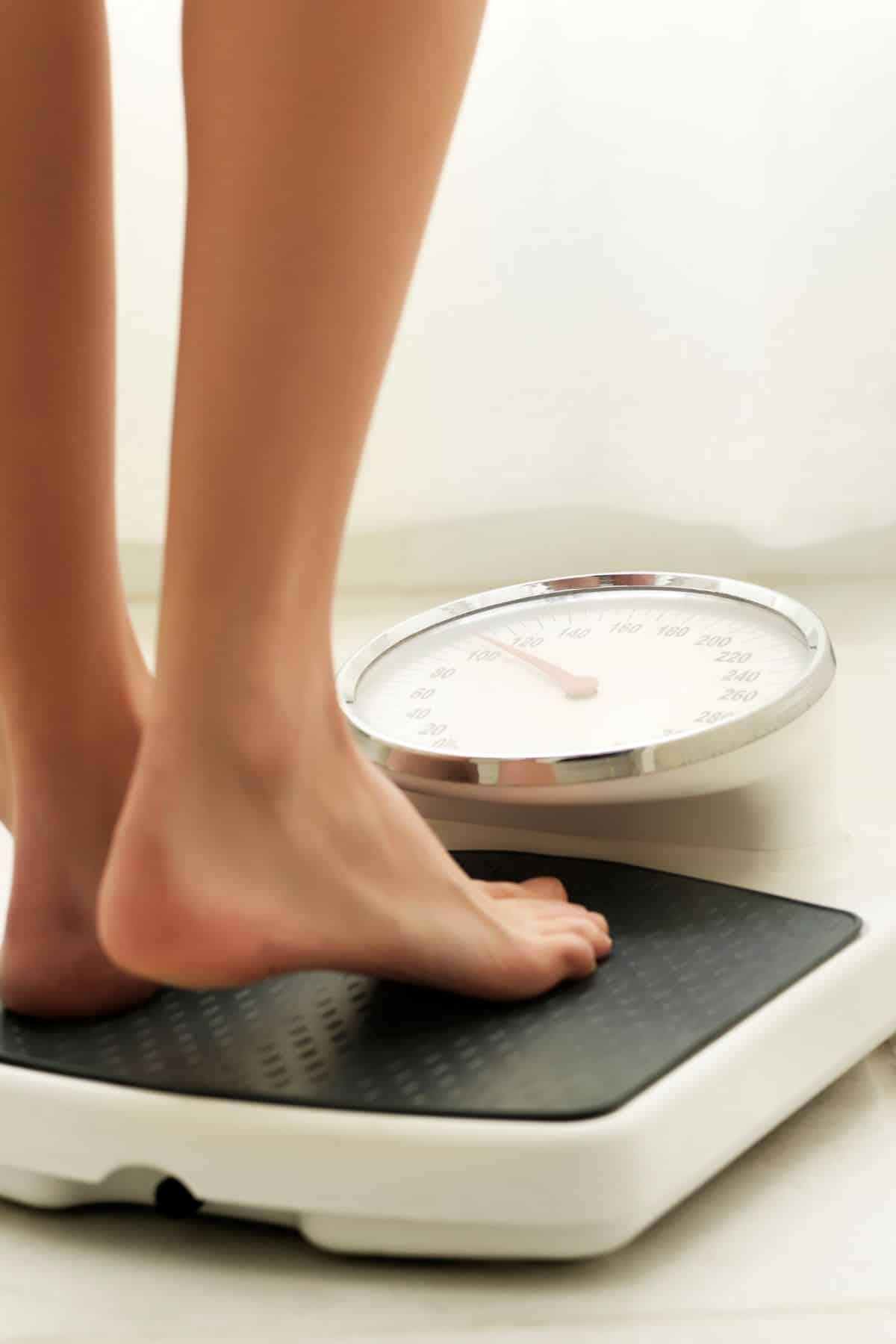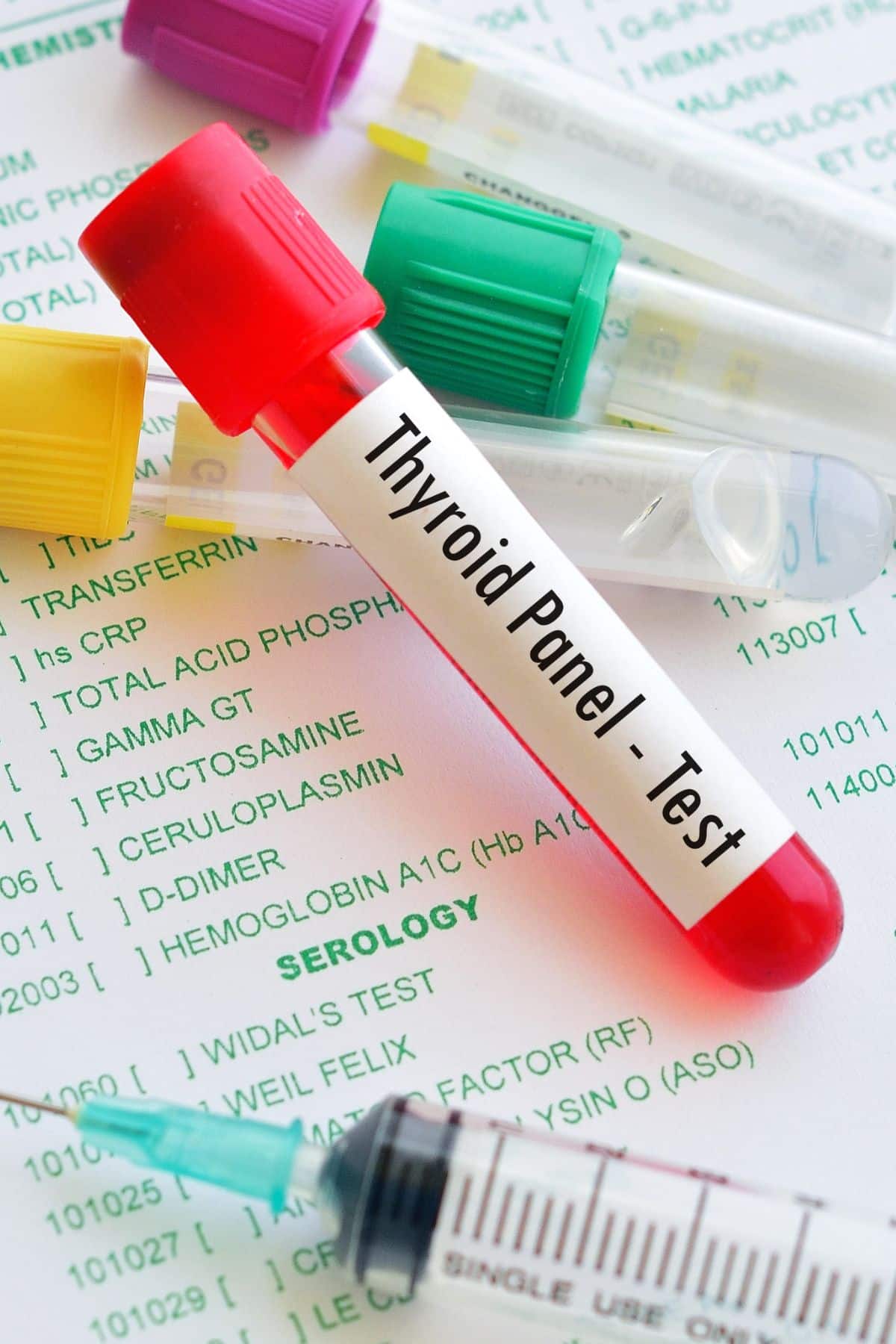9+ Best Tips for Losing Weight With Hashimoto’s
If you have been diagnosed with Hashimoto’s Thyroiditis, you might realize that you have trouble managing your weight or losing excess weight. In this article, I share the best tips for losing weight with Hashimoto’s, including my personal experience.

Overview of Hashimoto’s
Hashimoto’s disease is an autoimmune condition. Autoimmune diseases occur when your immune system mistakenly sees healthy cells in your body as harmful invaders and begins to attack them.
In the case of Hashimoto’s, the white blood cells that form part of your immune system attack your thyroid tissues, eventually leading to hypothyroidism. The result is that your thyroid gland no longer produces the level of hormones that your body needs.
Thyroid hormones are involved in many systems in your body and play an important role in growth and metabolism. When their levels are compromised due to an underactive thyroid, your metabolism can slow and you may begin to put on weight.
What triggers autoimmune disorders is a bit of a mystery. With Hashimoto’s disease – also known as Hashimoto’s thyroiditis – experts believe that the cause has both genetic and environmental components. This means that you could be genetically prone to the condition, and then certain factors within the environment act as triggers for its development.
It seems that women are more likely to suffer from Hashimoto’s disease than men and it is more common in middle-aged people.
Having pre-existing autoimmune disorders like lupus may make you more prone to developing Hashimoto’s disease, as may a family history of thyroid problems.
Other triggers may include hormonal changes connected to pregnancy or a diet that contains too much iodine. See my related article on the worst foods for Hashimoto’s.

How the Thyroid Affects Metabolism And Weight
The thyroid hormone has long been known to regulate your metabolism – the process your body uses to change the foods and drinks you consume into energy.
During the process of metabolism and other basic functions like breathing, your body burns calories. The number of calories you burn while at rest is known as your basal metabolic rate.
When your thyroid is not producing enough thyroid hormone, your basal metabolic rate slows down and you burn fewer calories. Weight gain is the result, with the actual amount usually related to the severity of the condition.
Hashimoto’s has been identified as one of the leading endocrine (hormonal) causes of obesity. This is because too high of a body weight may result in insulin resistance and can affect overall health.
Here is a related article on the signs of Hashimoto’s disease plus some additional tips for healthy weight loss for women.
Tips for Losing Weight With Hashimoto’s
1. Get a full thyroid panel to determine thyroid levels
The first – important – step is to get an accurate overview of your thyroid levels. These include lab values for your TSH (thyroid-stimulating hormone), free T3, and free T4.
It is not uncommon for Hashimoto’s patients to be told that their lab values are normal, when in fact they are on the higher side of normal. This low thyroid function can have a negative impact on the ability to lose weight.
This – and the fact that Hashimoto’s can have an intermittent effect on the thyroid, making it hard to detect – means that many women can wait for a long time before receiving a proper diagnosis and treatment.
Learn how to order your own thyroid labs at home.

2. Increase medication, if necessary
It’s extremely important to consult with your healthcare provider to ensure you’re taking just the right dose of thyroid replacement hormone.
To put this into perspective, consider that thyroid medications are dosed in micrograms. A microgram is a unit of mass equal to one-millionth of a gram! That means even the smallest difference in dosage can have a big impact on the way you feel.
A dose that is slightly too low may – indeed – bring your thyroid-stimulating hormone (TSH) level into the higher end of the range, but may not be quite enough to normalize your metabolism.
Most healthcare providers agree that a TSH level lower than 2 is ideal for relieving symptoms. If yours is at the higher end of the range, speak to your healthcare provider about increasing your dosage.
It’s also important to do all you can to ensure you absorb your medication properly.
Ideally, take it in the morning, at least 30 minutes to an hour before eating breakfast or drinking milk and or coffee.
You should wait for 3 to 4 hours after taking your thyroid medication before taking fiber, calcium, or iron supplements, or before consuming calcium-fortified products like juice. That’s because these supplements decrease the amount of medication that your body absorbs.
3. Get tested for infections and rule out Chronic Fatigue Syndrome
If you are still finding it hard to lose weight, it’s a good idea to ensure that there are no underlying infections contributing to the problem.
It’s also important to make sure you’re not suffering from chronic fatigue syndrome (CFS).
Studies have shown that there is a link between CFS and lower levels of thyroid hormones, but that it is still distinct from thyroid disease.
There’s no scientific research as yet that necessarily connects CFS with weight gain, yet anecdotal evidence suggests that the lower physical activity levels associated with CFS can make weight gain more likely.
Any type of chronic inflammation can lead to a decrease in overall health.
4. Do moderate exercise, but not too much
Exercise is important for anyone trying to lose weight. Not only does it help boost your metabolism, but it has other – less obvious – benefits too.
Exercising regularly as part of healthy lifestyle changes can:
- Reduce pain in your joints
- Help fight depression
- Increase your energy levels
- Improve your self-esteem
Ideally, aim for around 30 minutes of exercise several times a week, although you can break this into 10-minute chunks each day if that suits you better.
Exercise ideas include swimming, walking, yoga, pilates, and dancing. You might also want to consider focusing on strength-based workouts that build muscle.
Muscle weakness has been found to be one of the problems associated with Hashimoto’s disease, so working on increasing your strength via resistance or weight training could be useful. What’s more, there have been studies to suggest that increasing your muscle mass can help boost your metabolism.
The main thing is to find a form of exercise that you enjoy – then you’ll be a lot more likely to stick with it!
But you can have too much of a good thing, so be sure not to overdo your workouts.
Intense exercise can raise your cortisol levels, putting stress on your thyroid and ultimately depleting your precious thyroid hormones even further.
The aim is to leave you feeling energized and ready to tackle the world – not exhausted.

5. Consider a diet for autoimmune disease
Inflammation has been found to significantly contribute to Hashimoto’s symptoms. Unfortunately, inflammation is often triggered by the foods we eat.
A good way to keep your symptoms under control when suffering from Hashimoto’s disease – or any autoimmune disorder – is to follow something like the AIP (autoimmune protocol) diet. See my related guide on the AIP Diet for Beginners.
Other diets – like the Paleo Diet, Whole30, or the Mediterranean diet – may be useful. But the AIP diet is one of the most highly recommended for people with Hashimoto’s disease trying to lose weight.
The focus of this diet isn’t on cutting calories, which can often lead to a deficiency in important nutrients. Drastically cutting calories can also trick your body into thinking you are starving. This is counter-productive, as your metabolism will automatically slow to hang onto the calories your body thinks it needs.
Instead, the AIP diet (and other diets recommend for autoimmune disorders) helps you identify and eliminate foods that trigger inflammation (also known as food intolerances).
These foods will vary from one person to another, so there is no set list of foods that are safe to eat. Instead, you will need to start off by eliminating inflammatory foods like gluten, dairy, and soy, then slowly reintroducing them to spot which one(s) triggers your symptoms.
This approach has been proven to be more effective in helping people with thyroid conditions lose weight than diets that simply cut calories or low-calorie diets.

6. Reduce added sugars
Too much added sugar in the diet is a known cause of weight gain.
It can raise your blood sugar levels and give you artificial feelings of fullness, leading you to eat too much later in the day.
One type of sugar – fructose – can even increase your levels of the hormone that makes you hungry, so you end up consuming even more!
Sugar is also known to have an inflammatory effect on the body, worsening the symptoms of autoimmune disorders like Hashimoto’s disease.
To consume less sugar, try these tips:
- Gradually reduce the amount of sugar you add to drinks like tea or coffee until you can enjoy them with very little, or none at all.
- Choose water over sugary canned drinks.
- Use naturally sweet fruit like bananas to sweeten your breakfast oatmeal.
- Add sweet spices like cinnamon and nutmeg to foods in place of sugar.
- Avoid fruits canned in syrup.
See my tips for doing a sugar detox to hep reduce extra weight.
7. Prioritize sleep
The importance of a good night’s sleep is often underestimated when it comes to weight loss. But there are several ways in which a lack of sleep can make it harder to lose weight.
Feeling tired can be a big barrier to exercise. It can also tempt you into eating convenient, processed foods rather than taking time to prepare healthy meals. There is even research to back this up, with scientists discovering our food choices become very poor when we are sleep deprived.
Another issue is that a lack of sleep can cause your cortisol levels to spike – a signal to your body to conserve energy instead of burn off calories!
In this study, participants cut back on their sleep for 14 consecutive days but consumed the same number of calories. The amount of weight they lost dropped by a whopping 55%!
Ideally, aim for around 7 to 9 hours of sleep per night.
Turn off all electronic devices one hour before bed and make sure your bedroom is completely dark. Try to create a relaxing nighttime ritual like having a bath, and try to stick to the same schedule of retiring and waking each day, even at weekends.

8. Manage stress levels
As mentioned earlier, stress triggers the production of a hormone called cortisol. Cortisol then places a lot of stress on the thyroid, further depleting your thyroid hormones.
Researchers have found that engaging in stress-relieving practices can be very helpful for women with Hashimoto’s. Reducing stress was shown to lower thyroid antibodies, reduce anxiety and depression, and improve the quality of life for women involved in the study.
So how can you lower your stress levels? Here are some ideas to try:
- Practice meditation
- Rest when your body tells you to
- Limit your caffeine intake
- Eat a healthy diet rich in vitamins
- Enjoy regular exercise
- Try yoga
9. Find more joy in your life
Sometimes we feel that we need to lose weight in order to feel happy. But it’s actually easier to shed the pounds if our mental health is good and we start out with a happy mindset.
This helps us make better health-related decisions and gives us the motivation to exercise, cook nutritious meals, and look after ourselves.
It may sound easier said than done, but there are ways in which we can increase our satisfaction with our lives and the world around us.
Here are some tips for increasing your happiness:
- Do the things that give you pleasure. Too often we put ourselves last and prioritize everyone else’s needs. But how can you help others if your own health is suffering? Take time to dance, hike, sing, or do whatever it is that you enjoy the most.
- Get up five minutes earlier each day and take that time to do something simple that starts your day off well. This could be anything from savoring your morning coffee alone to sitting outside and listening to the sounds of nature.
- Keep a gratitude journal. This is a useful tool for tracking the special things in life and a way to remind yourself of the many things there are to be grateful for.
- Volunteer your time. Helping other people is immensely rewarding and has been proven to increase feelings of well-being and happiness.
- Nurture your relationships and spend as much time as possible with friends and family.

FAQs
Losing weight is a problem for many people, but having Hashimoto’s can make it a whole lot harder. This is because the condition causes your body to work against you, slowing your metabolism and making burning calories more difficult.
But that doesn’t mean to say that trying to lose weight is futile. As you’ve seen in this article, there are many practical steps you can take to control your Hashimoto’s symptoms and give your metabolism the boost it needs.
The American Thyroid Association doesn’t recommend the use of thyroid hormones as a weight loss tool.
Although excess thyroid hormone treatment has been shown to help with weight loss in the short term, the weight is usually regained when the treatment ends. There have been negative repercussions, too, and patients have been found to lose muscle along with body fat.
The conclusion is that thyroid hormone treatment has no significant long-term effect on weight loss and may cause other metabolic problems.
Not likely. Fasting or following an overall low-calorie diet may actually be counterproductive when you have symptoms of hypothyroidism. Learn more about the risks of fasting for women.
My Experience
I had my thyroid removed with my thyroid cancer diagnosis back in 2012. I found it difficult to adjust to life without a thyroid, and my metabolic health and energy suffered. First, I lost weight after dealing with the stress of my diagnosis. Then, I gained weight and found it more difficult to find healthy weight maintenance.
Over time, I’ve learned to become more comfortable with my body and accept that changes are natural. I also work closely with my functional medicine doctor to adapt my diet and lifestyle to my individual needs.
It’s been a challenge and I still have Hashimoto’s disease and thyroid antibodies. But, eating a gluten-free and dairy-free diet helps keep my inflammation low. I do frequent blood tests to make sure my thyroid hormone is optimized.
I have a lot of empathy for other women who are struggling to lose weight with Hashimoto’s. My best advice is to be kind and gentle with yourself and to remember that health and feeling good is the priority over the number on the scale.
Try to focus on a diet and habits that helps you feel positive and energized, and the healthy weight levels in a normal range should follow.
Don’t Miss These Weight Loss Resources
Conclusions
There’s no denying that losing weight with Hashimoto’s is hard work. But the simple changes to your diet, lifestyle, and mindset outlined here can go a huge way toward getting your symptoms under control and helping you reach a weight you’re happy with.
Don’t forget to join my newsletter list to get exclusive clean eating recipes and tips. The newsletter is 100% free with no spam; unsubscribe anytime.
About the Author: Carrie Forrest has a master’s degree in public health with a specialty in nutrition and is a certified holistic nutritionist. She is a top wellness and food blogger with over 5 million annual visitors to her site. Carrie has an incredible story of recovery from chronic illness and is passionate about helping other women transform their health. Send her a message through her contact form.
Note: this post is for informational purposes only and is not intended as medical advice. Please consult your healthcare provider for recommendations related to your individual situation.




















